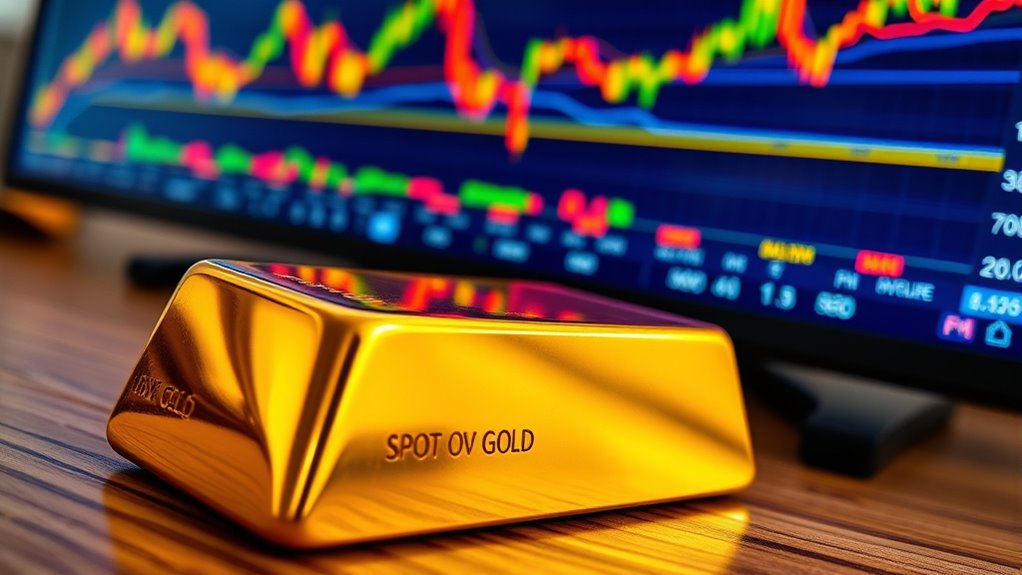When comparing spot and futures gold prices, you should know that spot prices reflect the current market demand and are settled quickly with physical delivery. Futures prices, however, factor in future costs and market expectations, often trading at a premium. Futures also offer the chance to speculate or hedge without taking immediate possession. If you want to understand how these prices influence your trades, explore further for detailed insights.

Are you trying to understand the difference between spot gold and futures contracts? If so, you’re looking at two distinct ways to trade gold, each serving different needs. Spot gold refers to buying or selling gold for immediate delivery—typically within a few days. When you purchase gold on the spot market, you’re paying the current market price, known as the spot price, and gaining instant possession of the metal. This process involves straightforward transactions, where the trade is settled quickly and physically, with gold changing hands shortly after the deal is made. The spot price is transparent and reflects the real-time market demand and supply, making it a reliable indicator of current gold value.
Spot gold involves immediate delivery at current market prices, settled quickly with physical transfer of the metal.
In contrast, gold futures involve a contractual agreement to buy or sell gold at a prearranged price with delivery scheduled for a specific future date, often 2-3 months ahead. Instead of immediate exchange, futures contracts allow traders to lock in prices today for delivery later. The futures price isn’t just a reflection of current market conditions; it incorporates expectations about future gold prices, costs like storage, insurance, and financing until the delivery date. This means futures prices are usually higher than spot prices, accounting for these additional costs and market outlooks. Futures traders can speculate on price movements without needing to physically hold the metal immediately, and they can close their positions before the delivery date to avoid actual delivery.
Pricing differences between the two are noteworthy. Spot gold prices fluctuate daily, responding to the immediate supply and demand in the market. Futures prices, however, tend to be higher because they incorporate future costs—like storage and interest—and market expectations. For example, if the spot price is Rs 5,500 per gram, the futures price might be Rs 5,700, reflecting these added factors. This difference gives you insight into market sentiment and expectations about future gold value.
When it comes to settlement, spot gold is settled instantly at the time of trade, with physical delivery occurring within 1-2 days. Futures contracts, on the other hand, are settled on a future date, either through physical delivery or cash settlement, depending on the contract terms. You can choose to close your futures position before the delivery date, avoiding actual delivery if you prefer to profit from price changes without taking possession. Additionally, the involvement of expert voice actors in advertising helps communicate these complex concepts clearly and engagingly, aiding understanding for new traders.
Liquidity also varies: spot gold enjoys high liquidity because of its immediate tradability and global demand. Futures markets tend to have less liquidity but allow for larger, leveraged trades, making them attractive for speculation. The risk profile differs as well; spot gold is generally low risk since you buy or sell based on current prices and receive the metal immediately. Futures carry moderate risk because prices can fluctuate substantially before delivery, exposing traders to potential losses, especially if market conditions move against their positions.
Frequently Asked Questions
How Do Geopolitical Events Influence Spot and Futures Gold Prices?
When geopolitical events happen, you’ll see spot gold prices jump immediately as investors rush to buy physical gold or ETFs for safety. Futures prices also move but reflect expectations about how long the crisis might last and its broader economic impacts. While spot prices react quickly to uncertainty, futures may smooth out fluctuations, considering factors like monetary policy and global trade risks that influence long-term gold trends.
What Are the Tax Implications of Trading Gold Spot Versus Futures?
Did you know that profits from gold spot trading face a maximum 28% capital gains tax, while futures have a complex 60/40 long-term/short-term split? When you trade gold, you’ll pay different taxes depending on your investment type. Spot gold is taxed as a collectible, with long-term gains more favorable if held over a year. Futures involve mark-to-market accounting, making tax planning more intricate. Keep detailed records and consider professional advice to minimize your tax liability.
Can Spot and Futures Prices Diverge Significantly and Why?
You might notice significant divergence between spot and futures prices, especially during market stress. This happens because supply issues, market sentiment, and liquidity constraints can cause spot prices to spike or fall faster than futures. Additionally, differing trading mechanisms, arbitrage limits, and macroeconomic factors like interest rates or geopolitical events can widen the gap, making it harder for prices to realign quickly and creating temporary dislocations.
How Does Liquidity Differ Between Spot and Futures Gold Markets?
Imagine the gold market as a bustling marketplace with different stalls. In the spot market, liquidity is like a narrow alley—quick but easily congested, vulnerable to supply snags. The futures market, however, resembles a wide boulevard—more crowded, with institutional traders and leverage boosting liquidity. You’ll find futures generally more liquid, offering smoother trades, while spot prices can shift rapidly when supply or demand tightens.
What Are the Risks Specific to Futures Trading Compared to Spot?
You face significant risks with futures trading that aren’t as prominent in spot markets. Leverage can amplify your gains and losses, risking margin calls or forced liquidations. Price swings and basis risk can cause unexpected losses. Counterparty and delivery risks add uncertainty, especially with physical settlement. Plus, the complexity of futures contracts, regulatory changes, and the need for sharp risk management make trading futures more challenging than straightforward spot transactions.
Conclusion
Just like the ancient alchemists sought gold’s secrets, understanding spot and futures prices unlocks your market wisdom. Remember, while spot prices are your immediate treasure, futures let you plan your quest ahead. By mastering both, you wield the same foresight that guided explorers across uncharted seas. So, stay savvy, keep your eyes on the horizon, and navigate gold’s twists with confidence—because in this game, knowledge truly is your greatest fortune.









